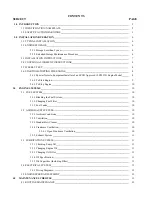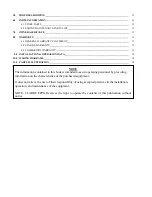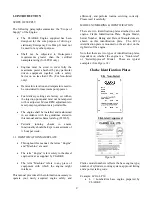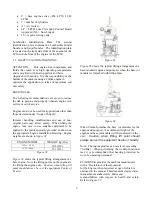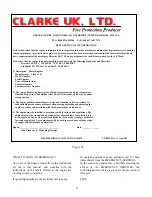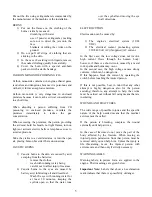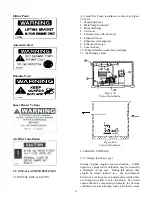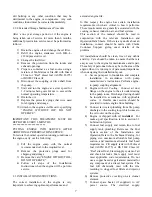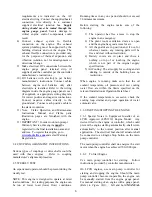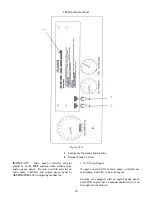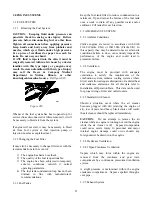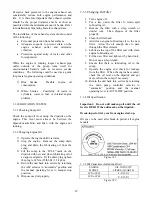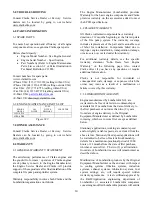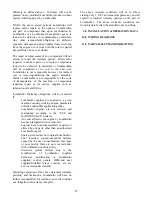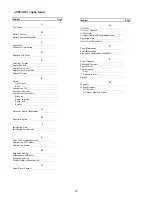
7
dirt buildup or any other condition that may be
detrimental to the engine or components. Any such
conditions found must be corrected immediately.
2.2.2 Extended Storage Maintenance Procedure
After a one year storage period or if the engine is
being taken out of service for more than 6 months,
additional preservation service must be performed as
follows:
1)
Drain the engine oil and change the oil filter.
2)
Refill the engine crankcase with MIL-L-
21260 preservative oil.
3)
Change the fuel filter.
4)
Remove the protection from the intake and
exhaust openings.
5)
Prepare a container as a fuel source using a
mixture of Mobilarma or Sta-Bil with Diesel
#2 fuel or “Red” diesel fuel (ASTM D-975)
or BS2869 Class A2.
6)
Disconnect the coupling or drive shaft from
the pump.
7)
Start and run the engine at a slow speed for
1-2 minutes being careful not to exceed the
normal operating temperature.
8)
Drain the oil.
9)
Replace the protective plugs that were used
for shipping and storage.
10)
Attach to the engine a visible card, specifying
“ENGINE WITHOUT OIL” DO NOT
OPERATE”.
IMPORTANT: THIS TREATMENT MUST BE
REPEATED EVERY 6 MONTHS
************************
PUTTING ENGINE INTO SERVICE AFTER
ADDITIONAL PRESERVATION SERVICE:
To restore the normal operation running conditions of
the engine, carry out the following:
1)
Fill the engine sump with the normal
recommended oil, to the required level.
2)
Remove the protective plugs used for
shipping and storage.
3)
Remove the card “ENGINE WITHOUT OIL,
DO NOT OPERATE”.
4)
Follow all steps of the Installation
Instructions when the engine will be put into
service.
2.3 INSTALLATION INSTRUCTIONS
The correct installation of the engine is very
important to achieving optimum performance and
extended engine life.
In this respect, the engine has certain installation
requirements, which are critical to how it performs.
These requirements are generally associated with the
cooling, exhaust, induction air, and fuel systems.
This section of the manual should be read in
conjunction with the relevant Installation and
Operation Data Sheets. If there is any doubt about an
installation, contact should be made with Clarke
Customer Support giving exact details of the
problem.
All installations should be clean, free of any debris
and dry. Care should be taken to ensure that there is
easy access to the engine for maintenance and repair.
The safety of personnel who may be in the area of the
engine when it is running is of paramount importance
when designing the installation layout.
1)
Secure pump set to foundation and complete
installation in accordance with pump
manufacturer’s instructions. Perform engine-
to-pump coupling alignment.
2) Engine with Air Cooling: Connect air duct
flange on the engine to the air outlet ducting
in the pump room. Discharge ducting should
be installed in accordance with applicable
codes. A flexible duct section should be
provided to isolate engine from building.
3) Connect raw water plumbing from fire pump
discharge to the cooling loop which comes to
the oil cooler on the engine.
4)
Engine is shipped with oil
installed
. For
make-up oil specification refer to section 3.3
Lubrication System.
5)
Connect fuel supply and return line to fuel
supply tank plumbing. Reference the Fuel
System section of the Installation and
Operation Data in the Technical Catalog, for
piping size, maximum allowable fuel pump
suction, and maximum allowable fuel head
requirements. Fill supply tank with #2 diesel
fuel (ASTM D-975) or BS 2869 Class A2
“Red” diesel fuel, bleed supply system of air
and check for leaks. Fuel supply level must
meet applicable code requirements. Do not
use a copper based or galvanized material for
any component of a diesel fuel system. The
fuel will chemically react with the zinc
resulting in clogged fuel filters and injector
systems.
6)
Remove protective covering on air cleaner
element.
7)
Connect space heater (if supplied) to AC
power source. The electrical supply


